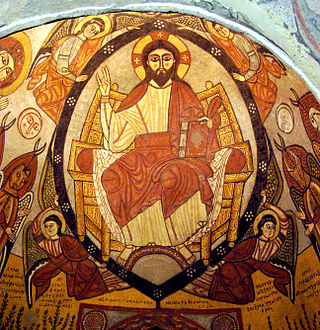Related Research Articles
An ecumenical council, also called general council, is a meeting of bishops and other church authorities to consider and rule on questions of Christian doctrine, administration, discipline, and other matters in which those entitled to vote are convoked from the whole world (oikoumene) and which secures the approbation of the whole Church.
The Fourth Council of Constantinople was held in 879–880. It confirmed the reinstatement of Photius I as patriarch of Constantinople.

Photios I, also spelled Photius, was the ecumenical patriarch of Constantinople from 858 to 867 and from 877 to 886. He is recognized in the Eastern Orthodox Church as Saint Photios the Great.
Pope Nicholas I, called Nicholas the Great, was the bishop of Rome and ruler of the Papal States from 24 April 858 until his death. He is remembered as a consolidator of papal authority, exerting decisive influence on the historical development of the papacy and its position among the Christian nations of Western Europe. Nicholas I asserted that the pope should have suzerainty over all Christians, even royalty, in matters of faith and morals.
Domnus II was the Patriarch of Antioch between 442 and 449 and a friend of the influential Bishop of Cyrrhus, Saint Theodoret.

Council of Constantinople can refer to the following church councils convened in Constantinople :
Anastasius Bibliothecarius or Anastasius the Librarian was bibliothecarius and chief archivist of the Church of Rome and also briefly a claimant to the papacy.
The Patrologia Graeca is an edited collection of writings by the Christian Church Fathers and various secular writers, in the Greek language. It consists of 161 volumes produced in 1857–1866 by J.P. Migne's Imprimerie Catholique, Paris.

The Second Council of Ephesus was a Christological church synod in 449 convened by Emperor Theodosius II under the presidency of Pope Dioscorus I of Alexandria. It was intended to be an ecumenical council, and it is accepted as such by the miaphysite churches but was rejected by Chalcedonian Christians. It was explicitly repudiated by the next council, the Council of Chalcedon of 451, recognised as the fourth ecumenical council by Chalcedonian Christians, and it was named the Latrocinium by Pope Leo I; the Chalcedonian churches, particularly the Roman Catholic and Eastern Orthodox communions, continue to accept this designation, while the Oriental Orthodox repudiate it.

Ignatius or Ignatios was a Patriarch of Constantinople from July 4, 847, to October 23, 858, and from November 23, 867, to his death on October 23, 877. In the Catholic Church and Eastern Orthodox churches, he is regarded as a saint, with a feast day of October 23.

The Photian Schism was a four-year (863–867) schism between the episcopal sees of Rome and Constantinople. The issue centred on the right of the Byzantine Emperor to depose and appoint a patriarch without approval from the papacy.
In the history of Christianity, the first seven ecumenical councils include the following: the First Council of Nicaea in 325, the First Council of Constantinople in 381, the Council of Ephesus in 431, the Council of Chalcedon in 451, the Second Council of Constantinople in 553, the Third Council of Constantinople from 680–681 and finally, the Second Council of Nicaea in 787. All of the seven councils were convened in what is now the country of Turkey.
Metrophanes of Smyrna was a Christian bishop, Metropolitan of Smyrna, in the ninth century. He was a leader of the Ignatian bishops at the time of the Photian schism (867).

The Fourth Council of Constantinople was the eighth ecumenical council of the Catholic Church held in Constantinople from October 5, 869, to February 28, 870. It was poorly attended, the first session by only 12 bishops and the number of bishops later never exceeded 103. In contrast the pro-Photian council of 879–80 was attended by 383 bishops. The Council met in ten sessions from October 869 to February 870 and issued 27 canons.

In the 9th century, Christianity was spreading throughout Europe, being promoted especially in the Carolingian Empire, its eastern neighbours, Scandinavia, and northern Spain. In 800, Charlemagne was crowned as Holy Roman Emperor, which continued the Photian schism.
Peter was a Bulgarian noble and relative of knyaz (khan) Boris I who was in charge of diplomatic missions during the Christianization of Bulgaria. His position in the Bulgarian administrative hierarchy is unknown but it has been suggested that he had the title kavhan, i. e. the second person in the state after the monarch.
The Council of Constantinople of 867 was a major Church Council, convened by Emperor Michael III of Byzantium and Patriarch Photios I of Constantinople in order to address several ecclesiastical issues, including the question of Papal supremacy in the Church, and the use of Filioque clause in the Creed.
Gregory Asbestas was an influential bishop from Syracuse, who served thrice as Archbishop of Syracuse and later (879–880) as metropolitan bishop of Nicaea. A protégé of the Patriarch of Constantinople Methodius I, he played an important role in the church conflicts of the day, becoming one of the leading opponents of Methodius' rival and successor, Ignatius, who dethroned him. Asbestas consequently became a close ally of another opponent of Ignatius, Photius, and when Ignatius was deposed and succeeded by Photius in 858, Asbestas was reinstated and performed Photius' consecration. He was deposed again during Ignatius' second patriarchate (858–867). He wrote a Life of Methodius, and reportedly authored caricatures ridiculing Ignatius, but neither of these works survives.
Meloë was a town in ancient Lycia, located near Cape Kilidonia.